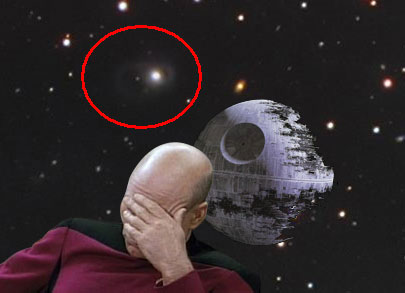------------------------------http://www.obspm.fr/actual/nouvelle/apr03/prg.en.shtml wrote:
Polar ring galaxies and dark matter
<<In general all disk galaxies obey the Tully-Fisher relation between their luminosity L and their rotational velocity V: L = k V4. The green line represents this relation on Figure 4 (each green point represents a normal galaxy). In contrast, polar rings do not obey this relation (see blue symbols on Figure 4). For a given luminosity, polar rings rotate faster than host galaxies. The rotational velocity is larger in the polar ring plane than in the equatorial host disk. This indicates that more mass is present in or along polar rings than in host galaxies, while the visible mass in polar rings is smaller than in host galaxies. The comparison of these data with numerical models shows that the only explanation is that the dark matter halo is flattened towards the polar ring.
Figure 4 - Relation between luminosity and rotational velocity for polar ring galaxies (blue symbols). Horizontaly, the velocity of the ring is shown (log of velocity), and Vertically the magnitude (2.5 x log of luminosity). The so-called Tully-Fisher relation for normal galaxies is shown by the green line; each green point is a normal galaxy. Host galaxies do verify this relation; polar rings do not and have larger rotational velocities than host galaxies, for a given luminosity.
The flattening of dark halos along polar rings can be confronted with the formation mechanism of polar rings. It has been shown that polar rings are formed during the tidal interaction of two galaxies, and the subsequent mass exchange between the two galaxies. The only solution to form a dark matter halo flattened along the polar ring, is that a large part of the dark matter is cold gas. This gas would be transfered from a galaxy to the polar ring, as is the case for the visible interstellar gas that is observed in polar rings. The dark halo would then be flattened along the plane of the polar ring. Around normal spiral galaxies, as our own, large quantities of cold gas would then be present, even if not observed, and would represent part of the dark matter of the Universe.
Figure 3 - Numerical simulation of the formation of a polar ring during the interaction of two galaxies. At the beginning, the future host galaxy (at the center) is a normal spiral galaxy. Another galaxy interacts with it, even if no merger occurs. Tidal forces are so strong that a part of the second galaxy is captured by the host galaxy and winds up around the host disk, to form the polar ring. The companion galaxy, after having lost most of its gas, escapes and runs away from the host. >>
Art Neuendorffer (former junior classmate of R. Brent Tully & J. Richard Fisher)





